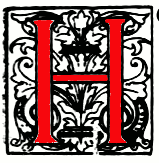

Left: Illuminated Initial Letters from Fust and Schoeffer's Bible in the British Museum from the 1845 Pickering edition of Henry Shaw's Alphabets, Numerals, and Devices of the Middle Ages. 38.8 x 28.9 cm. Collection: Updike Collection of Books on Printing, Providence Public Library. Right: Title-page from the 1853 Quaritch edition of Shaw's Hand Book of Medieval Alphabet and Devices. This item was catalogue no. 39 in Beckwith, Victorian Bibliomania (1987) [Click on images to enlarge them.]
Commentary by Alice H. R. H. Beckwith

enry Shaw's Alphabets, Numerals, and Devices was an important book for Gothic Revival architects and designers. In his preface, Shaw described his intended audience as working designers and amateurs who created and criticized "modern styles of Christian art" that drew on the formal vocabulary developed between the Saxon period and the Reformation. His objective was to improve contemporary historical design by convincing those working in the field that they ought to create ornament for all parts of their work under the inspiration of one particular epoch. He believed "an intimate acquaintance with every branch of decorative art in use at the same time" assisted in creating harmonious designs. Nonetheless, Alphabets; Numerals, and Devices lent itself to an eclectic mixing of styles, thanks to the breadth of historical and material sources represented in the forty-eight examples of lettering from metalwork, tomb sculpture, and hand-illuminated and printed books.



Three plates from a later book by Shaw, Hand Book of Medieval Alphabet and Devices (1853). [Click on these images for larger pictures.]
Charles Whittingham printed most of the illustrations in Alphabets; Numerals, and Devices from etched plates and colored wood engravings. However, for plate 12, which represents the transition from pen to press in the fifteenth century, some handcoloring was added. This plate is remarkable for the delicate range of its hues and as documentation of the dependence of the earliest printers on the hand arts for ornamenting their machine-crafted books.
The provenance of this copy illustrates Shaw's widespread influence, embracing England, France, and, in this case, two Americans who brought the lessons of William Morris's presswork to the United States, Daniel Berkeley Updike and Harold Brown. Brown and Updike published their Kelmscott Press-inspired Altar Book (cat. 12) during the 1890s. Alphabets, Numerals, and Devices apparently was bought by Harold Brown in Paris. Sometime after Brown died in 1900, Updike was given the book; in addition to his own bookplate, he had a commemorative bookplate printed for Brown and pasted it inside the back cover. The book received its final ex libris after 1937, when the Updike Collection of Books on Printing opened at the Providence Public Library.You may use the images from Hand Book of Medieval Alphabet and Devices without prior permission for any scholarly or educational purpose as long as you (1) credit the Internet Archive and the University of Toronto Library and (2) link your document to this URL in a web document or cite the Victorian Web in a print one.]
References
Beckwith, Alice H. R. H. Victorian Bibliomania: The Illuminated Book in Nineteenth-Century Britain. Exhibition catalogue. Providence. Rhode Island: Museum of Art, Rhode Island School of Design, 1987.
Shaw, Henry. Alphabets, Numerals, and Devices of the Middle Ages. London: William Pickering, 1845. Printer: Charles Whittingham at the Chiswick Press. Illuminator-Designer: Henry Shaw.
Shaw, Henry. Hand Book of Medieval Alphabet and Devices. London: Bernard Quaritch, 1853. Internet Archive version of a copy in the University of Toronto Library. Web. 1 January 2014.
Last modified 1 January 2014